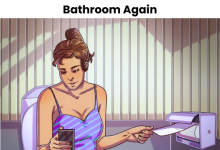Many people have the wrong idea about how to go about the process of bathroom cleaning, which can cause them to do more harm than good. In this article, we are going to highlight some common bathroom-cleaning mistakes that you need to avoid.
1.Clean Your Bathroom With Paper Towels

Haven’t you noticed you can go through a whole roll of paper towels before you’ve finished cleaning the bathroom? Not only are paper towels wasteful, but they’re not nearly as effective as a microfiber towel.
Microfiber cloths are made of ultra-fine synthetic fibers that pick up dirt and dust, allowing you to avoid using so many sprays. And because you can wash and reuse them, they’re environmentally friendly too!
2. Using Multipurpose Cleaner on Every Surface

While that bottle may say “multipurpose,” that doesn’t mean it’s appropriate for every surface in your bathroom.
Bath and tile should have their own product, as well as sink and countertops, and glass and mirrors. If you’re using the wrong kind of cleaner—say an acidic multipurpose solution on a granite counter—you could actually degrade the surface over time.
3. You Scrub Bathroom Tiles Too Hard

Dirty shower tiles can be infuriating, causing you to put all your elbow grease into making them sparkle. However, you shouldn’t have to break a sweat. The right cleaning combination — of scrubber and solution — should get the job done quickly and relatively easily, especially if you clean your tiles regularly. If you’re working hard, swap out the scrubber, the solution, or both!
4. Use Caustic Drain Cleaners

Caustic drain cleaners are extremely corrosive to organic materials and many metals. And while they may clear out a clog, they can also damage everything else they come in contact with.
If you have drain lines made of PVC or another type of plastic, you should never use a liquid drain cleaner, since it can eat through the plastic. If you have old metal pipes, the caustic drain cleaner could settle in the corrosion and pits found in the metal, which will eat away at your pipes.
5. You’re Using Water That’s Not Hot Enough

To clean your tub, sink or tiles, you should be using water 10 degrees above normal air temperature. Fill your tub or sink with the hottest water from the tap, let it sit for a few minutes, then scrub away with cleaner. By doing so, you can double the effectiveness of alkaline cleaners.
6. Cleaning Your Toilet With Lemon-based Products

Those lemon-scented cleaners may make your house smell good, but using them to clean your toilet will only cause problems in the long run.
The acid of lemon will wear down the rubber used in toilets and other parts of your bathroom, like your sink. So, avoid them at all costs.
7. Mixing Bleach and Acidic Products Together

Bleach can be an effective cleaner on its own—but mix it with vinegar or other acidic products could be a dangerous combination.
8. Using In-tank Toilet Cleaners

You may think it will say you time, but that in-tank toilet cleaner might cause more problems than it offers effective solutions.
Over time, these in-tank detergent dispensers that turn your toilet water blue are very hard on the plastic and rubber parts inside your toilet tank, causing them to weaken.
9. Wiping Without Dusting First

Without dusting before you clean the toilet, you’ll likely be smearing a wet trail of dust along the surface. Remove dust with a duster or your vacuum cleaner to avoid this mistake. As an alternative, you can always hire professional apartment cleaners to do the job for you.
10. Returning the Toilet Brush to its Cradle Before Letting It Dry

After scrubbing the toilet, most people put back the toilet brush in its cradle right away. Without letting it dry first, you’re just creating a pool of dirty toilet water that you’ll be dipping into frequently. Always dry your toilet brush under the toilet seat and allow it to drip into the bowl before putting it back in its holder.
11. Turning Your Exhaust Fan on After Cleaning

Turning your exhaust fan after a shower is a great way to reduce the development of mold and mildew in your bathroom. Turning it on after you clean, however, is just putting more work on your plate.
12. Using an Abrasive Cleanser or Sponge on Stainless Steel or Ceramic Surfaces

Harsh scrubbing cleansers can wreak havoc on more delicate bathroom surfaces. According to experts, using a cleaner that is too abrasive on stainless steel, your shower, or the tub floor damage to the finish.
13. Not Cleaning Behind the Toilet

It’s a very easy spot to overlook. No one wants to strain to reach between the back of the toilet and the wall. If you skip it, dust and hair will accumulate over time.
14. Using Baking Soda and Vinegar Incorrectly

Baking soda and vinegar are excellent cleaning agents, but using them together can cancel out vinegar’s disinfecting properties.
First, take advantage of the scrubbing power of baking soda. Sprinkle it in your bathroom sink and scrub with water and a sponge. Then, make use of the antiseptic properties of vinegar and spray it on bathroom surfaces to kill germs.
15. Leaving Lime Scale and Bleach Products on For Longer Than Indicated

While you don’t want to wipe up most cleaning products too early, leaving certain ones on for too long can cause just as much damage. This will always cause damage to your faucets and taps. So that, make sure to follow the instructions on the bottle to keep them from wearing down those surfaces.







